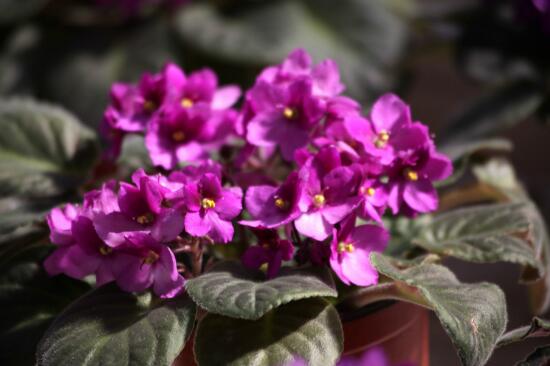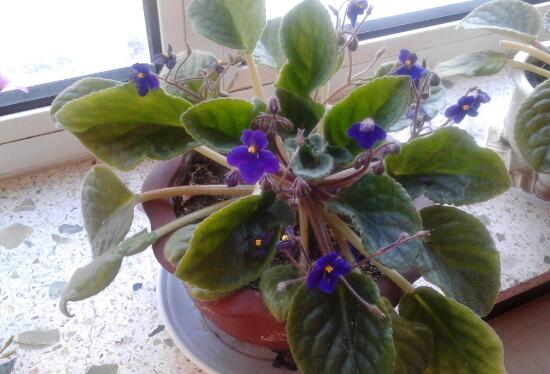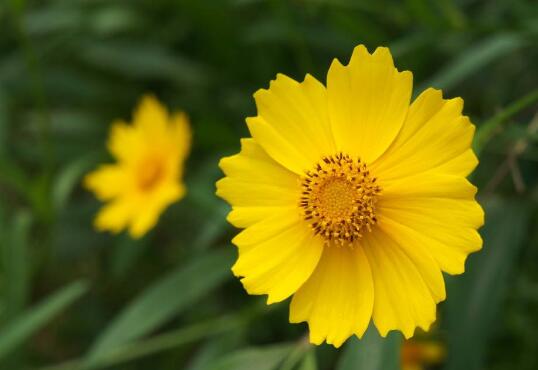How to raise African violets in winter, management methods of African violets in winter / multi-light heating up
Growing plants indoors, the biggest fear is winter, and African violets are no exception. Once the ambient temperature is too low, it will be frostbitten or even frostbitten to death. So how to raise African violets in winter? In order for African Violet to survive the winter safely, here are the winter management methods of African Violet carefully arranged by Xiaobian. Let's go and have a look!
1. How to raise African violets in winter

African violets like a warm semi-overcast environment, the night temperature in winter can not be lower than 12 ℃, so how to raise African violets in winter? First, move the African violets to a place with good indoor light, then keep the room temperature no less than 12 ℃, and then water and fertilize properly. By doing so, your African violets will basically survive the winter safely.
II. Winter management of African violets
1. Temperature
In winter, the most important thing to pay attention to in conserving African violets is the temperature. It is understood that African violets like to be warm, and growth stops when the temperature drops below 16 ℃. Although it can endure a low temperature of 7-10 ℃ for a short time, it is also easy to die over a long time. So how to raise African violets in winter, the room temperature should not be lower than 12 ℃.
2. Lighting
African violets are shade-tolerant plants, but they need plenty of light. Once they are in too much shade for a long time, they will blossom less and grow leaves without flowering. So in winter, in order to get enough light for African violets, they should be placed in places with good light, such as sunny windowsills.
3. Watering
In winter, although African violets grow slowly, they are also growing, so watering should continue. However, in winter, watering should be reduced, and the watering interval should be controlled at 7-10 days. In addition, when watering, do not let the water touch the leaves, of course, it is best to master the watering method of African violets, so that it is not easy to make mistakes.
4. Humidity
African violets like the humid environment, it is also very high requirements for moisture, in the air is relatively dry environment, is not conducive to growth. In winter, it is precisely a very dry time, so how to raise African violets in winter? We should increase the air humidity appropriately. Generally speaking, it is best to keep the air humidity between 40% and 70%.
5. Fertilizer
When it comes to the winter management of African violets, there is one thing we need to pay attention to, that is, fertilization, do not continue! Although African violets have a high demand for fertilizer, it also has something to do with light. If it is winter, the light will not be very strong, at this time fertilization will not have any effect. Therefore, it seems that we can consider applying only base fertilizer instead of topdressing.
How to spend the winter, the winter management method of African pansy / heating and light supplement / reasonable water and fertilizer
For African pansy, I believe that flower friends are no stranger, it is also called African Violet, is a very beautiful flower, often potted indoors. While growing plants indoors, what I fear most is winter. At this point, African pansy is no exception. How does African pansy survive the winter? The following is the winter management method of African pansy, follow the editor to learn it!
How to spend the winter with African pansy
According to the growth habits of African pansy, it likes warm environment and astigmatism, and the temperature at night can not be lower than 12 ℃, so how does African pansy survive the winter? First, move the African pansy to a place with good indoor light and keep the ambient temperature above 12 ℃, then water and fertilize properly. After doing so, believe that your African pansy can survive the winter safely.
II. Management methods of African Corydalis in winter
1. Adjust the temperature
How do African pansy survive the winter? First, move it indoors and adjust the temperature to more than 12 ℃. It is understood that the most suitable growth temperature of African pansy is 16-24 ℃. Once the temperature is lower than 16 ℃, it will stop growing. Although African pansy can endure a low temperature of 7-10 ℃ for a short time, it is easy to die over a long period of time.
2. Supplementary lighting
For African pansy to survive the winter safely, in addition to heating up, it should also be placed in a place with good light, such as a sunny windowsill. Although African pansy is a shade-tolerant plant, it needs plenty of light. Once it is in too much shade for a long time, it will blossom less and grow leaves without flowering.
3. Continue watering
As the temperature rises, there is light, and the African pansy will continue to grow in winter, so watering should continue. However, in winter, watering should be reduced, and the watering interval should be controlled at 7-10 days. In addition, when watering, do not let the water touch the leaves, of course, it is best to master the watering method of African pansy, so that it is not easy to make mistakes.
4. Stop fertilization
When it comes to winter management of African pansy, there is one thing we need to pay attention to, that is, do not apply fertilizer! Although African pansy has a high demand for fertilizer, it also has something to do with light. In winter, the light will not be very strong, at this time fertilization will not have any effect. Therefore, do not apply fertilizer at this time, otherwise it will produce fertilizer damage, thus affecting plant growth.
5. Increase the humidity
How do African pansy survive the winter? In addition to the above points, there is another point that we need to do, that is, to improve the humidity of the air. The reason for this is that African pansy likes a humid environment, and the weather can be very dry in winter, which is not good for plant growth. Therefore, in winter, we should appropriately increase the air humidity. Generally speaking, it is best to keep the air humidity between 40% and 70%.
How to water flowers, watering methods flower farming must be reasonable watering, flower breeding technology, reasonable watering of cultivated flowers and plants cultivation is relatively simple, rainy areas should pay attention to drainage, especially after rain should be timely drainage, such as long drought without rain, also need appropriate watering, flower culture technology, keep the soil moist, do not make soil tortoise, so as not to damage the root system. Flower culture technology, land cultivation must not flood irrigation, conditional gardens, can use sprinkler irrigation and drip irrigation.
The watering quantity and frequency of planting flowers and trees vary according to the varieties of main flower cultivation, flower culture technology, growth period, meteorology and soil. According to the soil moisture conditions, the following points should be paid attention to in the concrete operation:
According to the annual growing season of flower breeding and irrigation, the temperature in summer is high, evaporation, watering, plant growth stops in winter, and under the condition of low temperature, there is little water and no filling. One day, irrigation is always in the morning, but in summer, water evaporates quickly, so it must be around the afternoon when the reperfusion1; is cold in winter. Irrigation may be disadvantageous, preferably at 11: 10 in the morning. According to plant species and growing period irrigation, wet broad-leaved plant irrigation, leaflets, conifers, cactus reduce irrigation. Flower culture technology, seedlings should reduce irrigation, into the growing period and flowering stage (need to watch fruit) should be more irrigation, seed maturity should not be irrigated, dormant period, control irrigation. In addition, paulownia, African violet leaves, flower African chrysanthemum buds are perishable from water, these special cases should be paid attention to.
According to the soil to determine the amount of watering and watering times sand, porosity, water storage capacity, easy to waterlogging, appropriate irrigation. " Chaotic clay wet, dry knife ", pay attention to the flood, but also pay attention to prevention, timely loosen the soil, appropriately reduce the number of watering, each watering should be increased. Rich in humus, loose texture, large water storage, not easy to dry, not easy to waterlogging, under the same conditions, pouring water and frequency can be reduced, therefore. Flower culture technology, reasonable watering of potted flower varieties, watering potted flower varieties and planting flower varieties have something in common. According to the water quality, the temperature of the water, but also according to the temperature and growth stage of various plants, as well as the growth of time, appearance, weather changes, "look at the sky to see irrigation, irrigation", choose the appropriate watering time and the appropriate amount of watering. The root growth of potted flower varieties is limited, so the water species is complex. Potted flower varieties also pay special attention to "potted watering".
When the temperature rises in spring, flowers and trees wake up from dormant buds. Quickly, some buds begin to grow, and the demand for water begins to increase, especially in the northern spring breeze, where the first water after the flower room is drenched with a spring, and then gradually warms up, plant nutrition institutions expand, transpiration and evaporation are strengthened, that is, gradually increase watering times, shorten 2 watering intervals, usually by the spring interval watering1 times of 2to3days, increased to 1 / 2 days of watering1 era. Flowers and trees in spring every year, so fashionable in the seedling stage, small, relatively slow growth, small water consumption, usually reduce watering, basin soil temperature, affecting seedling growth.
In the hot summer, the weather is sunny and sunny. In the season when most flowers breed and grow most vigorously, leaf transpiration and soil evaporation increase rapidly. Only by further increasing watering times and water quantity to meet the water demand of flower cultivation, water at least once on a sunny day. People are often aware of the hotter weather and even the hot and dry weather, the basin surface evaporates strongly, and the water content of the basin soil drops rapidly, which is the most potted watering season of the year and the largest amount of water. Flower culture technology, potted summer drought is a serious threat, a little careless, can cause drought withered to death. Therefore, when the sun will be watered once sooner or later, the basin soil under special circumstances will be replenished in time. But in summer dormancy or semi-dormancy, in flowers, such as cyclamen, watering times and water should be reduced. Try to keep moderately dry, but not too dry, dry summer dormant plants is a disadvantage.
Flower culture must be reasonable watering, flower culture technology, autumn is the late transition period of summer, the sun weakens, the temperature gradually drops, flowers and trees bonsai will slowly grow period, leaf transpiration and soil evaporation in summer and the corresponding decrease is obvious, generally 2~3day watering one time. Flower cultivation must be irrigated reasonably. According to the cultivation techniques of flowers, winter is the lowest temperature in the whole year of this season, and the most potted flower varieties become overwintered indoors. The withered buds of deciduous trees are dormant at this time.
- Prev

How are African violets watered? how often are African violets watered / every 3-7 days?
When raising African violets indoors, what florists like most is watering. If it is a veteran, it is OK to say that it will be watered in real time according to the growth status of the plant, but if it is a novice, it will not be easy. There is no idea how long and how much African violets will be watered. So how are African violets watered?
- Next

How to raise Chrysanthemum morifolium, breeding methods and precautions / plenty of sunshine
Chrysanthemum morifolium is a perennial perennial herb of Compositae, which can be seen in many parts of our country, but if we want to raise it well, there are many places we need to pay attention to. How to raise it? What are the breeding methods and matters needing attention of golden rooster chrysanthemum? Next, the editor will take you to learn about it.
Related
- Fuxing push coffee new agricultural production and marketing class: lack of small-scale processing plants
- Jujube rice field leisure farm deep ploughing Yilan for five years to create a space for organic food and play
- Nongyu Farm-A trial of organic papaya for brave women with advanced technology
- Four points for attention in the prevention and control of diseases and insect pests of edible fungi
- How to add nutrient solution to Edible Fungi
- Is there any good way to control edible fungus mites?
- Open Inoculation Technology of Edible Fungi
- Is there any clever way to use fertilizer for edible fungus in winter?
- What agents are used to kill the pathogens of edible fungi in the mushroom shed?
- Rapid drying of Edible Fungi

